
We’ve analyzed hundreds of threads and thousands of posts on the MarksDailyApple.com forum and have come up with this list of the most common challenges. Next to each concept is a quick tip that might help your effort and prompt you to refer to the book over time for additional guidance.
Breakfast ideas: Omelet or other egg dish, green smoothie with fat and protein content (coconut milk, Primal Fuel powder, avocado). Let go of the idea that there are “breakfast,” “lunch,” and “dinner” foods and embrace more flexibility to eat intuitively. Or simply skip a meal when your fat-burning genes are fine-tuned and you’re not hungry.
Handling budget issue: Look at the big picture and prioritize expenses. The impact on your budget might actually be offset by getting rid of processed carbs and sweetened beverages and hitting your local farmers’ market.
Dealing with non-primals (spouses, kids, etc.): Set an example through your results and energetic disposition, rather than by lecturing. Avoid preaching to resistant folks and focus on those ready to receive your guidance.
Dining out: Be assertive and request menu flexibility to piece together suitable meals centered around animal protein. You can stay primal-aligned at most any restaurant by making some careful choices and requests.
Eliminating chronic cardio: Balancing stress and rest is the key to fitness progress! Adopt an intuitive approach to exercise instead of compulsively logging miles or reps in the name of “consistency.” Strictly monitor heart rate during cardio workouts to stay at or below “180 minus age.” This will likely involve getting your training partners on board or simply opting to do more of your cardio exercise solo so you can moderate your pace.
Finding good snacks: Review the list of my favorites on pages 225-226. Discover your own favorites from the extremely broad list of primal-aligned options.
Getting enough fat: Inadequate fat intake is likely influenced by decades of cultural programming to minimize intake of all fats, despite the health benefits of many types. Eat as much fat as you desire to enjoy meals, achieve satiety, and eliminate carbohydrate temptations. Just make sure you choose from the list of healthy, approved fats.
Getting enough sleep: Implement the sleeping tips detailed in Chapter 8 and in the Primal Blueprint quick tips that follow, paying particular attention to creating a calm, quiet, dimmed environment the final two hours before bedtime.
Giving up diet soda: Artificial sweeteners confuse your appetite hormones, triggering sugar cravings and even insulin surges. Try flavoring carbonated water (mineral or soda water, not tonic water!) with a generous squeeze of lemon and a bit of salt to get your carbonation fix. There are also several brands of unsweetened, naturally flavored carbonated water on the market now.
Giving up grains: Face it—grains are bland-tasting. It’s the stuff you put on grains that makes them taste good! Reframe your perspective about what you really need and reject rigid SAD traditions. Eggs for dinner? Steak for breakfast? Knock yourself out!
Engaging in Intermittent Fasting: The best bet for novices is to eat dinner, then delay breakfast the following morning until hunger sensations are compelling. See how long you can comfortably last without food, then enjoy a delicious primal-approved meal. Check your progress each month, as your ability to regulate energy without ingested calories provides a good indication of how well your genes have been programmed to make you a fat-burning beast.
Finding quick/easy food: Advanced planning is important, since the modern world will not provide very well for your primal needs on the go. Create a stash of temperature stable, easily transportable primal snacks (jerky, apples, nuts, trail mix, Primal Kitchen bars) so you can always have ready-to-go options available.
Learning to cook: Start with simple recipes, build your confidence, and get ever more creative over time. Check out Primal Blueprint Quick & Easy Meals or Paleo Primer for simple, fun, non-intimidating recipes. Keep your kitchen well-stocked to make things easy.
Listening to your body: Cultivate an intuitive approach to eating, exercise, sleep, and other primal behaviors. This means you must reject external influences (superficial cultural messages, peer pressure, judgmental family and friends) and answer to yourself first and foremost.
Listening to hunger signals: Eat when you’re hungry, finish when you’re satisfied. Give yourself permission to eat whatever you want, whenever you want, as much as you want (within primal guidelines of course) to achieve dietary satisfaction and promote health. Slow down your eating pace to really tune in!
Managing expectations: Focus on the intrinsic value of living primally, and don’t attach your happiness or self-esteem to the results. Take what your body gives you each day (energy, motivation, health, etc.) and never force results on an unnatural time schedule. Stop holding yourself to perfectionistic standards, and let go of the notion that there is some ideal you can and should attain. Trust that the immediate sensations you experience from promoting optimal gene expression (more energy and regulated appetite, hormone, and immune function) will translate into long-term results with body composition and other peak performance goals. Judge your “success” by how good you feel.
Managing stress: Minimize insulin production, eliminate chronic exercise, and align sleep habits with the circadian rhythm. Build momentum with these three big ones, and let further lifestyle refinements fall into place.
Overthinking things: Some passionate primal folks actually go overboard and become inflexible and anxious about their adherence to primal guidelines. This type of mentality, however well-intentioned, can compromise mental and even physical health. Accept that there is a range of potential outcomes—from magazine cover model to ordinary but extremely healthy. Don’t get bogged down with external results instead of honoring the most important big picture goal of primal living: long-term health.
Packing lunch/preparing meals: Cook large portions ahead of time, then refrigerate or freeze for quick meals on the go. Chop and store veggies to facilitate quick salad preparation. Portion out barbecue or crock pot meat dishes for quick reheating.
Playing more: Schedule grand outings and involve others. Get involved with kids—the world’s foremost experts on play. If you’re really out of practice, start small with a five-minute break from work or a quick stop at the park on the way home.
Reading food labels: Should you really be eating food with labels on it?! Emphasize fresh plant and animal foods and minimize consumption of wrapped, packaged, canned, and frozen foods. That said, read labels to avoid refined vegetable oils and sugars. Look at the carbohydrate count—this can clue you in to hidden sugars with sneaky names.
Resisting temptations: Why resist? Reject the struggle-and-suffer mentality and enjoy life! An occasional well-chosen treat is absolutely primal-approved. Honor the 80 Percent Rule and don’t stress about perfection or obsess about resisting temptations. Go with the flow and calmly return to your center if you happen to get thrown off track.
Scheduling meals: What for?! You will enjoy more flexibility with your schedule, shopping, and planning as you become more fat-adapted. The need to fuel with unfavorable options just because your body needs some calories will quickly diminish as you become adept at burning stored body fat.
Sourcing primal ingredients: Try backyard gardening (or renting an urban plot), farmers’ markets, co-ops, specialty grocers, or the Internet (if you live in a primal-challenged area).
Supplements: The best categories to supplement a healthy diet are: multivitamin/antioxidant, omega-3 fish oil, prebiotics, probiotics, high-protein meal replacement, and vitamin D for the sunlight challenged.
Satisfying sweet tooth: High-cacao-content dark chocolate (75 percent or above; ideally 85 percent) is a primal-approved treat that will satisfy your sweet tooth and provide an antioxidant boost.
Varying your diet: The primal guidelines afford tremendous variety in food choices. However, there is no rule that says you must eat a variety of foods. Personally, I’m a creature of habit and enjoy repeating my favorite primal-approved meals frequently. If you’re inclined to experiment and shake things up, go ahead and enjoy yourself!
Working out consistently: Striving for consistency is overrated! Consistency increases risk of injury from chronic exercise patterns and burnout. Focus on intuitively balancing stress and rest. Take what your body has to give you each day instead of blindly following a regimented workout pattern. Don’t feel guilty for skipping a workout if you don’t feel like it.
Motivating to exercise: People who can’t get or stay motivated to exercise generally view it as painful and overly stressful. Do workouts that are fun and make you happy. Head out the door for a hike, haul off a few PEM exercises on a whim, or rest if that is what your body requires. Don’t worry about burning a certain number of calories or moving at a certain pace; build momentum naturally with workouts that are fun and enjoyable.
Law #1: Eat Plants and Animals: Transforming your dietary habits is not easy, even for the most disciplined among us. The pull of comfort foods, cultural forces misaligned with health and balance, and our innate resistance to change must be skillfully negotiated. Find primal breakfast, lunch, and dinner meals and convenient snacks that you really love, and use these as a foundation for going primal. There are probably a dozen distinct omelet variations you can create from the starting point of cracking eggs into a mixing bowl.

While my eating habits vary wildly from day to day (see pages 470-475 for a 72-hour journal), I’d say my entire diet revolves around a midday Big Ass Salad that I make on many days of the week. Some days I’ll hit it around noon, after skipping breakfast or having a quick morning shake. Other days I’ll enjoy it in the late afternoon, providing me enough satisfaction and nourishment that dinner essentially becomes optional.
If you’re fond of nuts, prepare some individual servings for your desk, briefcase, car, and home, and make them your go-to afternoon snack. Building productive and easy-to-implement habits such as centerpiece meals or primal snack stashes should mitigate the chances of backsliding into quick-energy sweetened beverages or high-sugar energy bars when your hunger does strike.
Make primal eating simple and convenient by establishing some go-to breakfast, lunch, and dinner meals, and favorite snacks. Cycle through your five favorites as you build momentum going primal. Keep primal-approved snacks around.
Law #2: Avoid Poisonous Things: Out of sight, out of mind. What better plan to implement here than to simply avoid exposing yourself to health-compromising foods? This is particularly true when it comes to the struggle to wean children away from cultural traditions into a somewhat primal eating pattern. Establish firm guidelines for what is allowed in your home and don’t deviate from it. If the tee-ball team wins the championship and all are compelled to celebrate with hot fudge sundaes, your kid should go ahead and enjoy life to the fullest. This is different from stocking caramel sauce, chocolate syrup, and vanilla ice cream in your home for daily doses.

If you find yourself in the midst of tempting foods and are compelled to indulge, do so with a clear conscience and a total focus on the enjoyment that your treat provides. Often, when you reject the silly mind games of guilt and rebellion, you’ll discover that those few moments of gustatory pleasure experienced when the treat hits your taste buds are simply not worth the long-term negative consequences of digestive distress or acting in a manner incongruent with your big picture life goals.
1. Keep offensive foods out of your home, and stay away from junk-food establishments.
2. If you must indulge, do so with a clear conscience and total focus on the pleasure and satisfaction it provides. With taboos eliminated, you may realize that it’s not really worth it, and that primal-approved substitutes can provide similar satisfaction.
Law #3: Move Frequently: Own this idea about aerobic exercise: it’s not about the calories burned, it’s about the frequency of movement. If you are a cardio enthusiast, slowing down the pace of your workouts will promote fitness more than a chronic pattern of overly-strenuous workouts that compromises hormone, immune, and metabolic function. Apply your impressive levels of discipline and motivation not only to getting out the door and putting in the hours, but to backing off when your intuition suggests. You won’t get fat and lose fitness if you include more rest days and recovery sessions in your schedule, I promise! Remember, 80 percent of your body composition success is influenced by diet, and 100 percent of your fitness progress is influenced by common sense.

Focus on taking incremental measures to accumulate more total movement in everyday life, especially if you aren’t already very active. Contrary to what certain fitness pundits might spout, those 30-second hops up three flights of stairs, 5-minute walks around your corporate campus, and 15-minute strolls through the neighborhood with the dog definitely add up. You really can become aerobically fit without having a gym membership or a fancy spandex outfit. Just get out and move!
So many people get stuck because we’ve been conditioned to believe that there is no intermediate category between couch potato and diehard gym fixture. Tomorrow, examine your daily routine and identify five ways that you can replace mechanized or sedentary habits with physical movement.
Once in a while, go for an extended outing such as a hike that is paced comfortably enough that you’ll actually enjoy it and look forward to doing it again. If you’re nature-averse, make your hike of the urban variety. You can even walk or bike to a fun destination such as the farmers’ market, arranging ahead to get a ride back home. Make an effort to integrate flexibility/mobility activities into your “move frequently” efforts—things like yoga, Pilates, tai chi, basic stretching, and even self-myofascial release (foam rollers, etc.).
1. Slow down cardio workouts to avoid falling into a chronic pattern. During most of your cardio workouts, exert discipline to keep your heart rate below your maximum aerobic heart rate, which is calculated using the simple formula 180 minus your age.
2. Take incremental steps to increase overall daily movement—work breaks, errands, evening strolls, etc. Even a five-minute walk or ascending a few flights of stairs builds habits that support a more active lifestyle.
3. Get out for extended outings once in a while and enjoy nature or urban adventures.
4. Integrate complementary flexibility/mobility work to counter all the time spent in fixed positions.
Law #4: Lift Heavy Things: Again, let’s make things simple so there are no excuses or hurdles to making Law #4 a fun, comfortable, and consistent part of your lifestyle. The fitness/gym/bodybuilding scene is so laden with hype, complexity, intimidation, and “broscience” that even looking at a dumbbell or strapping into a spaceship-style strength-training contraption at the gym can be completely unappealing to all but the most fervent enthusiasts.

As a counterargument to the “broscience” that says you need “muscle confusion,” workout days cross-referenced against specific body parts, or multimillion dollar, 30,000 square foot gyms and top-dollar personal trainers to develop an impressive physique, allow me to assert: you can get extremely fit in just two intense workouts a week, lasting as little as 10 minutes and not more than 30 minutes. No equipment is necessary (except perhaps a pull-up bar), as your own bodyweight for resistance is all that’s required.
The Primal Essential Movements (PEMs) are four simple, safe, full-body functional exercises that can be done anywhere—backyard, park, or even a cramped motel room. These four exercises—pushups, pull-ups, squats, and planks—work the entire body in a functional manner to develop broad athletic competency. The PEMs are scalable to all levels of fitness through a series of progression exercises that are easier than the baseline essential movement. For example, chair-assisted pull-ups or wall pushups will allow a novice or someone with injuries or physical limitations to simulate the resistance and muscle recruitment of the PEM while doing an appropriate number of repetitions to build full-body strength.
Strive to complete one full-length PEM session and one abbreviated PEM session each week on days when energy, motivation, and immune function are strong. A full-length session involves two or more sets of maximum repetitions of each of the four PEMs. An abbreviated PEM workout involves a single set of maximum repetitions in each exercise. Start with two to five minutes of an easy cardiovascular workout before commencing your PEM exercises. After each exercise, take a 30- to 60-second break to get your breathing rate back to near normal. A full-length PEM circuit should take less than 30 minutes to complete, while an abbreviated PEM circuit should take less than 15 minutes.
1. Keep it simple with the PEMs: pushups, pull-ups, squats, and planks.
2. Use the progression exercises appropriate for your fitness level to achieve an appropriate number of reps.
3. Strive to conduct one full-length PEM circuit (two to three sets of max reps for each PEM) and one abbreviated PEM circuit (one set of max reps for each PEM) per week.
Law #5: Sprint Once in a While: If you are a fitness novice or otherwise intimidated about sprinting, try a few preparatory sessions where you simulate a sprint workout at 80 to 90 percent of maximum intensity. Known as “strides” or “wind sprints” in running parlance, you complete a series of efforts that are shorter and less intense than a maximum effort sprint. You can also do technique drills (high knees, heel kicks, mini-lunges—other movements that exaggerate running range of motion and help reinforce correct technique) to help prepare your muscles and nervous system for eventual workouts at maximum effort.
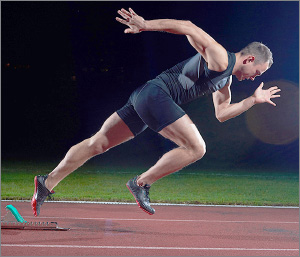
Almost everyone can eventually enjoy the optimal gene expression benefits of all-out sprinting when you conduct prep sessions at incremental intensities and eventually take it up to 100 percent. Utilize low-or no-impact exercises if running carries a high injury risk for you.
1. Sprint once every 7 to 10 days and only when you are 100 percent rested and motivated.
2. To prepare for the strenuous nature of sprinting, conduct lower intensity “strides” or “wind sprints” and choose low- or no-impact options if appropriate.
3. Refer to the forthcoming Sprint Workout Suggestions for details.
Law #6: Get Plenty of Sleep: Melatonin production has been triggered by darkness for all of human history. When you keep your evening environment unnaturally bright with artificial light or blast your eyeballs with digital stimulation from Netflix or YouTube, cortisol levels spike and carbohydrate cravings can occur, leading to sleep deprivation and excess body fat storage. As soon as it gets dark, minimize artificial light in your home. If you don’t want to use candles, try installing orange light bulbs (available at home supply stores) in commonly used lamps, especially in the bedroom. Or you can don glasses with yellow or orange lenses to block the disruptive “blue light” emitted from white bulbs. The tinted bulbs and lenses allow plenty of light in but do not disrupt the production of the sleep hormone melatonin in the manner that white light bulbs and digital screens do.

Mellow things out after dark by choosing relaxing endeavors such as reading, strolling, talking, and board games instead of digital entertainment. Create an ideal bedtime environment: simple, quiet, as dark as possible, clutter-free, cool (65°F seems to be the preferred sleeping temp), and keep it exclusively for sleeping. When you implement calm, relaxing evenings, you set yourself up for success on the other end: waking up naturally, without an alarm, feeling refreshed and energized. Even if you’re convinced that you’re not a morning person, exposing yourself to direct sunlight as soon as possible after awakening will help elevate serotonin and suppress melatonin, kicking your body into high-energy mode for a busy day.
1. Minimize artificial light after dark: Use minimal indoor lighting and orange bulbs or lenses.
2. Get your digital technology into night mode: Visit getflux.com and download a free program called f.lux for your computer. f.lux automatically alters the “color temperature” of your computer screen to align with ambient light—easier on the eyes after dark. If your cell phone or tablet offers a nighttime mode, always activate it if you must use your devices after dark.
3. Minimize digital stimulation: Especially in the final two hours before bedtime, choose reading, conversation, board games, or neighborhood strolls instead of going straight from screen to bed.
4. Bedroom: Get rid of all clutter and maintain a simple, stress-free environment. Try blackout curtains and keep the temperature around 65°F.
5. Sleep mask: A handy resource for napping and eliminating potential light distractions during your evening sleep.
6. Napping: Whenever you fall behind on sleep, a 20- to 30-minute nap during the day can help rejuvenate energy and brain function.
7. Morning: Awaken naturally, close to sunrise, and expose yourself to direct sunlight ASAP.
Law #7: Play: Take a few mini-play breaks throughout the day lasting 5 to 15 minutes, and schedule grand play outings once in a while that involve exciting new adventures with family and friends. There are few rules or restrictions to mini play breaks, except to let go of inhibitions and cultural pressure that discourage anything out of the ordinary. Don’t be afraid to get strange looks from co-workers when you start playing wastebasket hoops or attempt to juggle some tennis balls in the office courtyard. Don’t let the hectic pace of modern life stand in your way here—start modestly if you must with a five-minute endeavor. Once you become comfortable departing from your daily routine, you may experience bursts of creativity. When in doubt, hang around kids, and you’ll be playing in no time.

For your grand outing, take a few moments to jot down a wish list of adventures you and your loved ones might like to try. Rank them in order of priority, being realistic with your time and budget. Then, take a couple of initial steps today toward making it happen—schedule your rock climbing lessons, grab a hiking map from the state park website and plot out a route, or rent or purchase necessary gear. Plan the big day and stay accountable by involving others and getting a firm handle on logistics so the adventure is not too daunting when the time comes.
1. Make mini play-breaks lasting 5 to 15 minutes a regular part of your daily routine. Don’t overthink this; just take some time out for amusement.
2. Occasionally step it up with grand outings and adventures. Check things off your bucket list, and spend quality time with friends and loved ones while you’re at it. Start now by deciding what your next adventure will be, and take a concrete step or two toward making it happen.
Law #8: Get Plenty of Sunlight: For maximum vitamin D production, expose large surface areas of your skin (arms, legs, torso) to direct sun for about half the amount of time you think it takes to get slightly burned. This is a highly individual estimate based on time of year and day, skin pigmentation, latitude, reflectiveness of the ground surface, and other variables. Nevertheless, guesstimating the halfway mark is a pretty low-risk endeavor, so make a strong effort to expose as much skin as possible to direct sunlight during the months of the year when the sun’s rays are sufficient to manufacture vitamin D (year-round in the tropics; around eight months in the continental U.S.A.). If your climate/geography, skin color, or lifestyle make it difficult to obtain adequate sunlight during the summertime, definitely get your levels tested. If you are below 30 ng/mL, consider taking vitamin D supplements during the winter months, particularly. Even a sincere effort to obtain sufficient vitamin D from diet will fall well short. Get some sun!

To mitigate skin cancer concerns or reduce the cosmetic appearance of aging, cover frequently exposed, sensitive skin areas (face, neck, hands) with clothing or sunscreen—they contribute minimally to vitamin D production anyway.
1. Expose large skin surface areas to direct sunlight for half of “burning time” (or half the time it would take for skin to get pink) whenever possible, especially during times of day/year when sunlight is strong.
2. Routinely cover face, neck, and hands to prevent long-term overexposure.
3. Get tested if you have a sun-challenged lifestyle, and consider supplementing with vitamin D during winter months if necessary.
4. Make sure you are getting sufficient vitamin A, vitamin K, potassium, and magnesium through your diet, or supplement if necessary, since these work synergistically with vitamin D in the body.
Law #9: Avoid Stupid Mistakes: Reject the concept of humans as good multi-taskers. The human brain is literally incapable of multitasking. Instead, we divert our attention quickly back and forth between stimuli, making us more stressed, less focused, and more likely to make mistakes. Obviously texting and driving is foolish, but when you cut other corners while juggling a hectic daily schedule, bad things can happen. Is talking on a hands-free cell phone while driving cool? Many don’t think twice about this, but your brain is significantly less focused on driving while talking on the phone.

Be vigilant and manage risk intelligently by taking nothing for granted—not even a quick ride through town to the supermarket. Your own and other’s lives are in your hands each time you get behind the wheel; do you really need to have a phone conversation at the same time? Focusing on one task at a time throughout your day—even those that are mundane—will give you the discipline and resolve to stay focused when the stakes escalate, such as every time you turn the key and hit the road.
1. Multitasking is literally impossible for the human brain. Concentrate on a single task at a time to increase productivity and reduce stress.
2. Be vigilant and manage risk intelligently by taking nothing for granted. Respect the importance of even mundane tasks and hone your ability to focus.
Law #10: Use Your Brain: Engage in creative, intellectual pursuits that counter the grind of daily responsibilities. Give yourself permission to have fun, knowing that tapping into your creative side will enhance your performance in your core areas of responsibility and economic contribution. Get the most out of your brain by strictly filtering and editing the excessive amount of stimulation you are exposed to in daily life and taking frequent breaks away from tasks of intent focus to refresh brain function.

1. Find creative, intellectual pursuits to balance the daily grind: music, language, crosswords, Sudoku, model airplanes, fantasy sports leagues, or whatever interests you.
2. Find ways to stimulate and challenge your brain throughout the day, such as adding up numbers in your head or recalling names of acquaintances.
3. Treat your brain kindly: take frequent breaks to refresh focus and avoid burnout.
Strength training can be simple, convenient, and safe for everyone with the Primal Essential Movements (PEM). Pushups, pull-ups, squats, and planks collectively work all the major muscle groups of the body in a functional manner, providing benefits that are directly applicable to all types of everyday fitness, work, and play activities. You don’t have to feel intimidated venturing into a gym, nor assume the inherent risks of loading your body with external sources (meaning gym equipment) for resistance exercises. The PEMs are a great choice for novices and old hands alike because they use bodyweight for resistance, comprise simple movements that are easy to learn (and very difficult to screw up and get injured from), and have a series of easier progression exercises that approximate the familiar baseline movement. Even hard-core strength athletes can make the PEMs challenging enough to stimulate fitness breakthroughs.
Begin your strength-training sessions with a two- to five-minute warmup of low-intensity cardiovascular exercise (walking, jogging, stationary cycling, or other cardio machine at a heart rate of “180 minus age” or below). You should break a light sweat, indicating elevated body temperature, and be breathing at a comfortable rate. Conclude each workout with a two- to five-minute cooldown to allow sufficient time to return your breathing rate to normal. Be certain that you have medical clearance before attempting any strenuous workout, including those described in this book.
Next to each exercise listed are levels of “mastery” for males and females. The mastery levels represent your target performance in one set of maximum effort. Your first PEM workout should be an assessment session to determine, by trial and error, your maximum effort level for each essential movement. If you can’t complete the mastery number of reps for a particular Essential Movement, drop down to the appropriate progression exercise to enable you to complete a sufficient number of repetitions in your workout. As you improve your performance with your progression exercise, bump up to the next progression exercise or the baseline movement. Advanced strength trainers can integrate numerous adaptations to increase the degree of difficulty beyond the baseline Essential Movements, including donning a weighted vest for the entire PEM session.
Males - Primal Essential Movement mastery
50 pushups
12 pull-ups (overhand grip)
50 squats (thighs, just below parallel to ground)
Plank: 2 minutes holding the Forearm/Feet Plank position
Females - Primal Essential Movement mastery
20 pushups
5 pull-ups (overhand grip)
50 squats (thighs, just below parallel to ground)
Plank: 2 minutes holding forearm/feet plank position
Pushups (lats, pecs, triceps). Mastery = Male 50, Female 20. Assume pushup plank position (arms extended below you, hands forward, body straight). Lower to ground—chest touching first! Keep body dead straight, core and glutes tight, head and neck neutral to torso. Elbows bend backward at 45-degree angle as you lower.

Easiest Progression: Wall Pushups (M50, F30). Do standing pushups with your arms extended and hands resting against a wall. Maintain plank position as you lower to the wall and re-extend your arms to starting position.
Next Progression: Bench Pushups (M50, F25). Do pushups with hands resting on a bench or other object elevated from ground. Maintain plank position as you raise and lower.

Pull-Ups (back, lats, pecs, biceps). Mastery = Male 12, Female 5. Grasp bar at shoulder width with overhanded grip. Elbows tight, chin tucked, shoulder blades retracted to protect spine. Lead with chest up, keeping lower body quiet. Raise your chin over the bar and gradually lower all the way until your arms are straight (or just before straight if you have joint issues).

Easiest Progression: Chair-Assisted Pull-Up (M20, F15). Start with your leg loosely positioned on a support chair underneath the bar. Engage your upper body muscles and raise yourself up to the bar. Use just enough leg force to assist getting your chin over the bar. You probably only need to use one leg, but can use two if necessary. Yes, everyone can do pull-ups!

Next Progression: Chin-Up (M7, F4). Many find the chin-up to be slightly easier than a pull-up, particularly if you have wrist, elbow, or shoulder issues. Simply invert your grip on the bar so your palms face you, and raise yourself until your chin is over the bar.
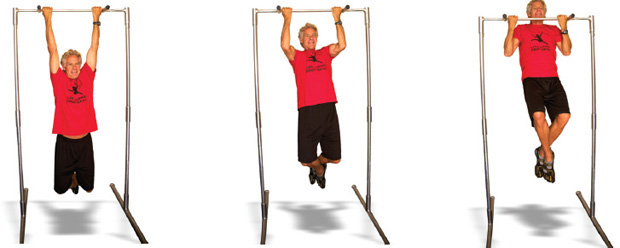
Squats (lower body). Mastery = Male 50, Female 50. Feet shoulder-width or slightly wider apart. Feet face directly forward, or if you must, point them slightly outward. Lower yourself by extending your butt out and bringing thighs to just below parallel to the ground. Envision screwing your feet outward into the ground—left foot counterclockwise, right foot clockwise—tracking your knees over your midfoot as you lower down. Strictly refrain from allowing the knees to cave inward. Maintain a straight spine (it will travel from a 90-degree to a 45-degree angle), but resist the urge to lean forward—chest up! Use your quads and buttocks to absorb the load both sitting and standing. Go down in a smooth and steady movement until your thighs are a bit past parallel to the floor. If you are flexible enough to lower all the way down (“ass to grass”) go for it (and work toward it!). Return...Return to a standing position without locking your knees, again making sure your knees track in line with your feet.

Easiest Progression: Assisted Squat (M50, F50). Hold pole or other support object while lowering into and raising up from squat position. Use support object as little as possible.
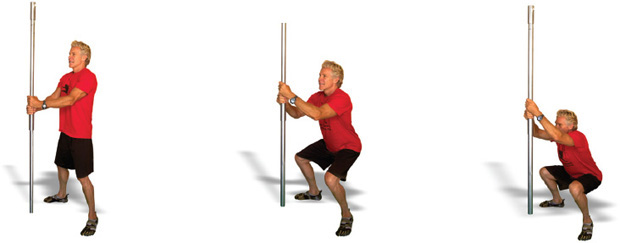
Planks (core and lower back, as well as shoulders, triceps, hip flexors). Mastery = Male 2 minutes, Female 2 minutes. Hold pushup plank position while resting your elbows on the ground. Maintain position until you can no longer maintain straight body position or your arms/shoulders fatigue. An optional movement to stimulate the oblique abs is to lean on one extended arm and rotate body into sideways plank position, preserving a straight line from your head to toe. Hold until failure, and then repeat on other side.
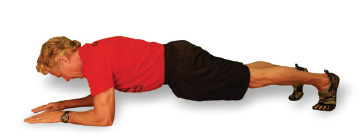
Easiest Progression: Forearm/Knee Plank (M 2 minutes, F 2 minutes). Assume plank position with forearms and knees resting on ground. Engage core muscles and glutes during exercise.
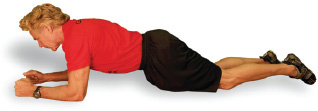
Next Progression: Hand/Feet Plank (M 2 minutes, F 2 minutes). Assume plank position a la pushup starting point, with arms extended and hands and feet on ground.

PEM Isolation: For a unique challenge, set an ambitious numerical goal for a single PEM and make that your entire workout one day. Perform reps until failure, then rest as needed and tackle additional reps, counting your accumulated total to reach your goal. For example, some mornings I’ll aspire to do 200 decline pushups. These might accumulate in sets as follows: 60, 50, 30, 25, 25, and 15. I might do half the sets in 10 minutes, then get sidetracked for 20 minutes before I finish off the last several sets.
PEM Sprint Workout: This is a fun session that’s over with quickly and integrates strength training and sprinting. It’s a great challenge to all of your muscle groups and your cardiovascular system.
• One set maximum effort pushups, then immediately sprint 80 meters. Rest 30-60 seconds until breathing returns to normal.
• One set maximum effort plank, then bunny hop 40 meters. Rest 30-60 seconds.
• One set maximum effort pull-ups, then sprint 80 meters. Rest 30-60 seconds.
• One set maximum effort squats, then bunny hop 40 meters. (Wow!)
Begin each workout with a five-minute warmup of low-intensity walking or jogging (heart rate of “180 minus age” or less) followed by light stretching. Conclude each workout with a five-minute cooldown identical to the warmup. Be certain that you have medical clearance before attempting any strenuous workout, including those described in this book.
After proper warm up, conduct six warmup strides of 5 to 8 seconds each, with a 20-second rest period between strides. Focus on maintaining good running form and don’t worry about your speed. These are just warm ups for your main sprint efforts. After your warmup strides, do six sprints lasting 8 to 20 seconds each at an estimated 90 percent of maximum effort. Take a one-minute rest period between sprints or otherwise enough to be fully recovered and achieve normal respiration before beginning your next sprint.
After two to three sessions over a few weeks’ time, increase your sprint efforts to nearly full speed. Use a moving start (jog up to starting line and then begin sprinting) instead of a static start, to minimize injury risk. Where you fall in the range of 8 to 20 seconds is personal preference. Naturally, shorter sprints will be at faster speeds. I like to include both shorter and longer duration sprint sessions into my schedule. Pay attention to the difference between leg fatigue and pain. If you experience any acute pain or tightness, particularly in your hamstrings, wrap up the workout immediately with an easy cooldown and refrain from further intense exercise until your condition completely clears.
Strides and sprint workout as described for novice workout, except build to maximum (controlled) effort on the sprints. Remember to deliver a consistent quality of effort on each sprint, and stop the workout if your time or perceived effort is unsatisfactory.
Six to eight times hill sprints lasting 8 to 20 seconds at 90 percent effort. Recover by walking or trotting down the hill. Return to normal breathing before beginning next effort.
Six to eight times 30-second sprints with the first 10 seconds at medium effort, second 10 seconds at hard effort, and third 10 seconds at full sprint. One to two minutes recovery between efforts. You can use a running track and do 150-meter repeats accelerating every 50 meters (start at turn apex, accelerate at straightaway, accelerate again at middle of straightaway, finish at traditional finish line) or any other course you can mark with one-third distance intervals.
• Strides: Four times eight-second strides at 90 percent effort. Ten-second rest between efforts. One-minute rest before next exercise.
• Skipping: Two to four times 50 meters. Drive knee as high as you can (try to hit your chest), taking off and landing on opposite leg. Then launch off and land with opposite leg, driving other knee high into chest—like an exaggerated skip. Strive for maximum height instead of length. Fifteen-second rest between efforts. One-minute rest before next exercise.
• Bounding: Two to four times 50 meters. Take as long a stride as possible, focusing on keeping your balance rather than speed. Thirty-second rest between efforts. One-minute rest before next exercise.
• Bunny Hopping: Two to four times 50 meters. Take off on both legs and jump up and forward. Focus on achieving a good balance between height and length. Swing arms to assist effort and ensure a balanced landing. One-minute rest between efforts (you’ll need it, trust me). Two-minute rest before next exercise.
• Full Sprint: Two to four times 50-meter full sprint. One-minute rest between efforts.
Conduct this workout on stadium or building stairs. Your flight of stairs should take 8 to 20 seconds to ascend. Take 30 seconds rest between each exercise, or more or less as needed to feel refreshed and get your breathing under control.
• Four times warmup stair climbs at 75-percent effort. When you reach the top, return immediately down the stairs at a comfortable pace, then ascend again.
• Two times single stairs. Ascend one stair at a time with rapid leg turnover. Descend comfortably and repeat effort.
• Two times bounding stairs. Ascend by skipping as many steps as you can. Focus on keeping your balance rather than speed. Drive arms for balance and leverage. Descend comfortably and repeat effort.
• Four times full speed stairs. Skip desired number of stairs with each stride to get to the top as fast as possible. Descend comfortably and recover completely between efforts.
This workout, inspired by MarksDailyApple.com regular Grant Peterson, is a refreshing example of the simplicity of fitness in a culture that habitually tries to make things more complex than they need to be. In the amount of time it takes to get through the basic set-up instructions of your heart rate monitor owner’s manual, you can capture the essence of Grok with this primal effort.
Take a 5- to 10-pound medicine ball (depending on your own body-weight and strength level) to an ample-sized athletic field. After a 5-minute light jog, grab the ball and throw it down the field. Sprint after it, pick it up and throw it again, completing repeat trips up and down the field. Discover numerous variations on the throw—overhead like a soccer throw-in, underhand like an old school free-throw, sideways one-armed like a discus thrower, sideways two-armed like a hammer thrower, roll like a bowling ball (one- or two-handed), or face backward and throw over your head two-handed. (Watch out for little kids at soccer practice with the latter.)
Be extremely careful to keep your spine and neck in a neutral position every time you throw. Your legs and core muscle groups will provide the most leverage and receive the most training effect from the throws. Your spine and neck should always be in a straight line (angle to the ground might vary from perpendicular to 45 degrees depending on your throwing style)—don’t curve your back or neck fore-aft or side-to-side. Make sure that the force of your effort is absorbed by your legs and core muscles.
Begin with gentle throws that will give you a form check. As you fatigue after a few lengths of the field, you will have to be especially diligent about maintaining proper body position for your throws. When you notice that your ability to maintain correct form becomes compromised due to fatigue, it is time to stop the workout; the same goes if you experience any acute pain in your muscles or joints. Finish your session with five minutes of easy jogging.
SPRINTING AWAY FROM MALIBU
While I’m aware of the need to address Primal Blueprint enthusiasts living in varied climates with varied options for exercise venues, I obviously have difficulty suppressing my enthusiasm for one of my favorite workouts: beach sprints. (Check out a session on video at MarksDailyApple.com.) As MarksDailyApple.com reader Robert McLeod commented, “Hey Mark, not everyone lives at the beach What about sprint workout suggestions for winter?” A stationary bike will work just fine, as will any building staircase for the “stadium” workout.
If you don’t have a suitable indoor venue, or you are feeling adventurous, try doing sprints on cross country skis, snowshoes, or ice skates. On my visits to the mountains, I’ve enjoyed doing sprints on snowshoes up a very steep hill in deep powder. It’s a fascinating athletic juxtaposition to compare the sensations of moving quickly on packed sand with barely moving up a steep hill at high altitude, while using the same motion and same effort level.

Cycling sprints should only be done on a stationary bike due to the high degree of technical difficulty and automobile danger associated with sprinting on a bike outdoors. Take a five-minute warmup on the bike at easy-to-moderate effort. For the main set, sprint 10 seconds, rest 10 seconds. Then a 20-second sprint with a 20-second rest. Then 30-second sprint, 30-second rest. Then another 30-second sprint, 30-second rest. Then a 20-second sprint, 20 second rest. Then a 10-second sprint, 10-second rest to complete the ladder workout. Five minutes easy pedaling cooldown.
Six to eight times 30-seconds all-out with two-minute recovery between efforts. The extended recovery time in this workout helps improve power—the number of watts you can produce at maximum intensity. The interval workouts (cycling workouts #1 and #3) are more focused on developing oxygen-carrying capacity, since recovery intervals are shorter in relation to work efforts. Note: Thirty seconds is longer than the maximum recommended running sprint of 20 seconds, because cycling is less strenuous than running.
Tabata is a workout system where you achieve a desired number of minutes of intense effort in sprinting, weightlifting, or any other maximum effort exercise, using the consistent work/rest ratio of 20-seconds sprint, 10-seconds rest, 20-seconds sprint, 10-seconds rest—repeated for usually four minutes by Tabata enthusiasts. Going for just four minutes is a great workout, but some people like to pedal slowly for a few minutes and then commence another one or two four-minute Tabata sessions.
While it’s encouraging to see the increasing mainstream acceptance of the primal/paleo/ancestral health eating style, we are still swimming upstream against the massive forces that have entrenched a grain-based diet into Western culture. If you are struggling in your mind about who is “right,” I believe any confusion can be alleviated when you consider a larger context and the different paradigm the Standard American Diet operates in.
Proponents of the SAD try to convince us that humans need to center our diet around carbohydrates, especially grains. Furthermore, they want us to believe that the many diet-related health problems with which so many people struggle are due to factors other than carbohydrate consumption. And yes, eating fat while eating excessive amounts of processed carbohydrates (especially in comparison with our ancestors) can contribute to excess body fat due to the high insulin production.
When you reject the flawed starting point of a grain-based, high-carbohydrate diet, you begin to see the rationale of the Primal Blueprint in its proper perspective. Carbohydrates are not required to survive. Our evolutionary history and any scientist will confirm this. If you eat primally, your fat-burning genes will upregulate (or turn on) and you won’t need regular meals to get through the day. If insulin and glucose are not running rampant in your bloodstream (thanks to cutting back on carbohydrates), then your risk of systemic inflammation and cellular damage is greatly minimized. At this point, eating fat—lots of the right kinds of fat—will support health and long-lasting energy.
If you are still conflicted, try ditching grains and sugars for 21 days and see how your body reacts. Or, if you have been struggling with weight management, check out the Success Stories link at MarksDailyApple.com to get a sense of the physical transformation people are experiencing when they go primal—on the heels of years of frustration from trying conventional diets.
Beyond the glaring distinction between primal eating and a grain-based, high-carb diet there are certain other points to consider. Vegetarians will have objections to my emphasis on meat, but these objections are almost entirely countered (saving the philosophical ones, which involve a personal belief system and not a dietary quality debate) by emphasizing local, pasture-raised animal products and consuming high-antioxidant vegetables and fruits along with your meat.
If you’ve seen research suggesting that meats and high-fat diets are unhealthy, this conclusion is likely heavily influenced by eating overcooked or heavily processed meat laden with nitrites and other toxins; consuming high-fat foods in conjunction with moderate-to-high-carb diets (because insulin drives the fat into storage and promotes systemic inflammation that allows ingested cholesterol and saturated fat to cause trouble in your arteries); consuming partially hydrogenated trans fats and refined high polyunsaturated vegetable/seed oils (troublemakers who get the whole class of “fat” blamed for their bad behavior); and obtaining insufficient high-antioxidant foods such as fresh organic produce.
Some dieticians argue that the avoidance of whole grains and legumes compromises nutrient intake, since these foods have long occupied a prominent position in the diet recommended by conventional wisdom. We already know that grains and legumes stress the insulin response system and are inferior sources of vitamins and minerals—particularly on a per calorie “bang for your buck” basis—compared to other plants and animals. Furthermore, a grain-based diet results in excessive fiber consumption and health risks associated with the aforementioned anti-nutrients (lectins, glutens, and phytates) on a noticeable allergic level and a more insidious subclinical level.
Those in the low-fat camp might shudder at all the fat that primal enthusiasts enjoy from animal meats, fish, fowl, eggs, avocados and avocado oil, nuts and seeds, coconut products, butter, olives and olive oil, and dark chocolate. However, we know that heart disease is related more to excessive insulin production and the inflammatory elements of your diet than it is to fat intake. The continued popularity of the sentiment that too much fat is bad for you simply blows my mind. It’s time to separate once and for all good fats from bad. Fortunately, the health dangers of partially hydrogenated trans fats are now well accepted, and the backlash against toxic refined vegetable oils is building. Meanwhile, the health benefits of consuming omega-3 and monounsatured fats are being widely embraced.
We’re getting there, but we need to also recognize that saturated fat is not evil either—unless you wolf down too many carbs in conjunction with them or rely exclusively on feedlot animals, overly cook them, or fail to consume high-antioxidant plant foods.
Dr. Ron Rosedale, author of The Rosedale Diet and acclaimed for reversing type 2 diabetes, obesity, and heart disease through diet, says, “A high-complex-carbohydrate, low-saturated-fat diet is an absolute oxymoron. A high-complex-carbohydrate diet is nothing but a high-glucose diet, or a high-sugar diet. Your body is just going to store it as saturated fat (since we have very limited glycogen stores in muscle and liver), and the body makes it into saturated fat quite readily.”
“Who will be the biggest loser this week?”—goes the tag line of the popular boot camp weight-loss competition on television. The answer is definitely the public. You simply can’t lose 10 or 20 pounds of body fat in 10 or 20 days—period. It’s a parlor trick. Most of the weight lost is from reduced water retention (four grams of water bond with every gram of stored glycogen in the body). Some of the weight lost is precious muscle, leaving only a small fraction of the impressive total as actual body fat. What’s more, contestants follow extremely low-calorie diets that are still carbohydrate-heavy and feature plenty of processed, low-fat, artificial-sugar-laden frankenfoods. At the “finish line” of extreme, unsustainable crash diet/workout efforts, big losers are left depleted, exhausted, and prone to a rebound effect of overeating and under-exercising. This is the human organism’s survival instinct kicking in and trying to restore, replenish, and recover from the hormonal and metabolic disregulation caused by the extreme experience of a crash diet.
You may have heard the oft-reported government survey figure that 97 percent of dieters gain the weight back within five years. Also troubling is a recent study from Dr. Traci Mann, a UCLA psychology professor who tracked the long-term success rate of participants in 31 popular diets. The study reported that 41 percent of participants gained back more weight than they lost within one year. While Mann admitted the number seemed “depressing,” she also revealed that “we have strong reasons to feel that this number under-represents the true number of participants who gained back more weight than they lost” due to people dropping out of contact due to embarrassment and people crash-dieting right before the study period ended to save face!
What a complete mess we are in. We need to take a step back and adjust our collective mentality to approach the subject of healthy eating with a fresh perspective. There is no reason why any of us should suffer from excessive body fat, emotional stress, or disappointment on the subject of eating. I am advocating a variable, intuitive eating style that includes a tremendous variety of delicious foods and minimal (from one point of view anyway!) restrictions. Furthermore, I am not irresponsibly pitching the Primal Blueprint eating style as the end-all secret to good health and longevity; the best outcomes result from combining primal-style eating with the other Primal Blueprint behaviors. Ignoring them is a recipe for failure. For example, an extreme endurance athlete immersed in a stressful training program (burning carbs for hours on end every day) will probably crash and burn if he suddenly switches to eating Primal Blueprint style. For such an athlete, we must first address the issue of sensible training methods before turning our attention to dietary habits (details in the book Primal Endurance).
The Primal Blueprint works because it isn’t a diet, it doesn’t involve depriving or exhausting yourself, and because you make all the decisions about how to make it work best for you within the general guidelines laid out in this book. As with any diet or lifestyle modification, if you don’t enjoy it and truly believe in what you’re doing it can’t be sustainable long term. The estimated two million sincere primal/paleo enthusiasts know that a Primal Blueprint-aligned lifestyle works. I believe the logic behind it is unassailable—and who could argue that we shouldn’t be eating real, delicious food, exercising in a fun, intuitive manner, enjoying time in the sun, playing, getting enough sleep, using our brain creatively, and avoiding stupid mistakes? I trust that if you take the leap, the results will speak for themselves.
I’ve taken advantage of the infinite capacity of the Internet to augment this book with continually updated supporting material. The direct links are as follows:
marksdailyapple.com/the-book/references/primal-blueprint-text-references/
marksdailyapple.com/the-book/references/suggested-reading/
marksdailyapple.com/the-book/references/primal-blueprint-resources/
marksdailyapple.com/the-book/references/questions-and-answers/
All About Grok
Dispute About Recent Human Evolution
Directing Cellular Function
Reconciling Evolutionary Rationale with Religious Beliefs
Grok and Korg Nicknames
Diet
Differing Scientific Conclusions
The “Evolutionary Rationale”
Insulin-Balanced Meals
Fiber
Diet Sodas
Exercise
Compliance for Low-Body-Fat-Athletes
Cortisol
Natural vs. Synthetic Human Growth Hormone and Testosterone
Lifestyle
Getting Kids’ Buy-In
Prescription Drugs
Primal Blueprint Comparisons to Popular Diets